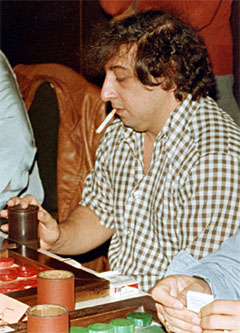|
| Magriel's NYT Columns |

Chuck Papazian Charles (Chuck) Papazian, one of the world’s finer players, acquired his backgammon expertise at the Mayfair Club in New York. His brilliant positional play enabled him to win the International Grandmasters Tournament in 1975. He now resides in Berkeley, Calif., where he recently won the Fifth Annual Pacific Backgammon Championships.
A natural games player, he is working as a consultant on the computerization of chess, bridge, and backgammon. Last month, while in New York, he returned to the Mayfair to test his skills against old rivals.
Papazian demonstrated his fine technical ability in the diagrammed position, which occurred here in a late-night chouette. On the previous roll, White, with 7 men borne off, was forced to leave a man exposed on the 20-point.
Papazian (Black) was naturally disappointed not to throw a 1, which would have hit and made him a favorite.
|
| Black to play 5-3. |
In other words, Black seeks to get at least one man off before White completes his bearoff. Without delaying, Black must bring his two back men into his home board as quickly as possible. Remaining with both men on the 21-point in hopes of White rolling 1-1’s followed by a 1 for Black would be folly. This play would work out less than 1 time in 100 and would greatly increase Black’s chance of being gammoned.
The correct play is 21/13, running all the way with one back man. At first inspection, this play appears pointless — why not simply play 21/18, 21/16, removing both back men from White’s home board? What can Black possibly gain by keeping a single man back on the 21-point? After all, by staying back, there is no chance of getting another shot at White. Furthermore, doesn’t Black run the risk of being hit by White and consequently slowed down in his race to save gammon?
|
|
|
The danger of Black’s being hit by White is less significant than first appears. In fact, if White rolls a 6-1 or 5-1 he would be foolish to stop to hit Black. It would be wiser for him to take men off rather than hitting, which would cost him a whole roll. Only if White rolls a 4-1 (2 combinations out of 36) does Black lose anything at all by staying back with one man.
Rollout
 Tom Keith 2013 |
|
Money play Black owns 2-cube Black rolls 5-3 1296 games with VR Checker play: 2-ply Cube play: 3-ply Red |
| 5-3: | Game | G | BG | Equity | ||||
| 1 | 21/18, 21/16 |
W L |
.0000 1.000 |
.0000 .5922 |
.0000 .0000 | −1.5922 |

| (b) |
| 2 | 21/13 |
W L |
.0002 .9998 |
.0000 .5937 |
.0000 .0005 | −1.5938 | (0.0016) | (a) |

|
|

